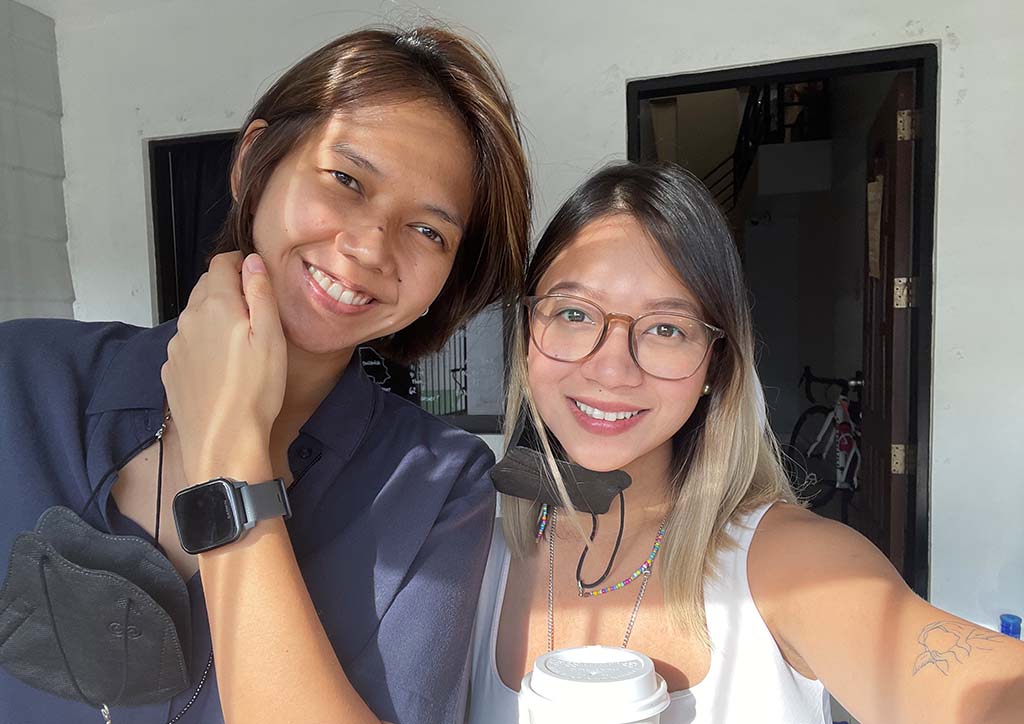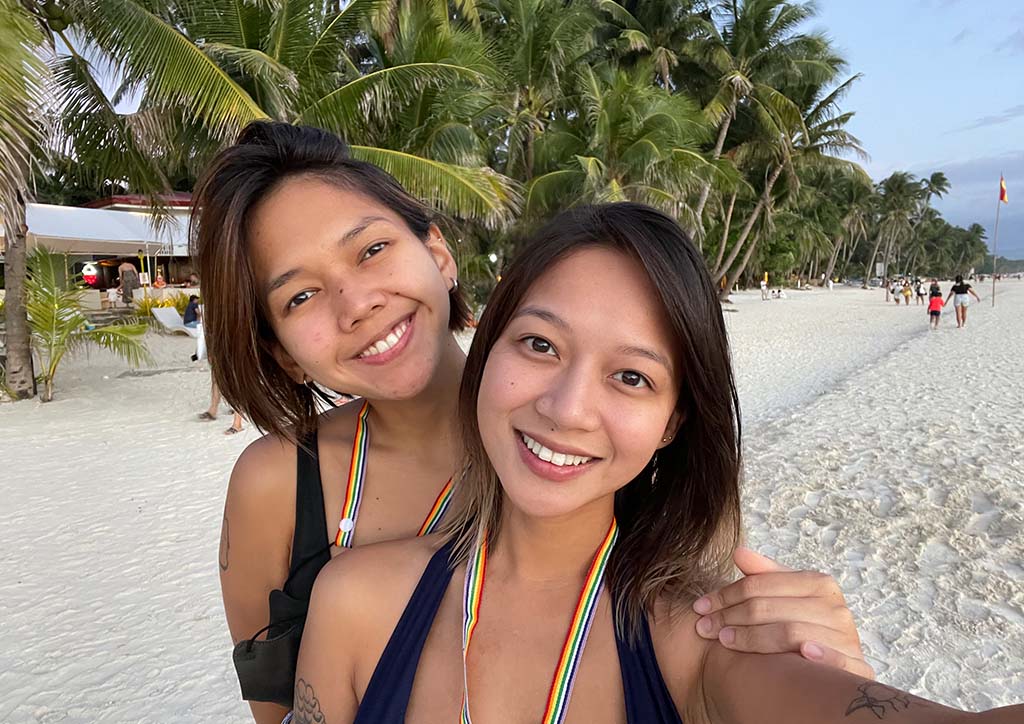Uncategorized
This Couple Shares How Families Can Be Better Allies to the LGBTQ+ Community
Ina and Jen open up to Modern Parenting about how families can help create a safer and more welcome space for those part of the LGBTQ+ community.
For many members of the LGBTQ+ community, being their true selves can often be a struggle—especially if they’re part of a conservative family. Modern Parenting talked to Ina and Jen, who shared their respective dynamics at home, how to deal with traditional family members, and different ways that more families can create a safer and more inclusive environment for their children.
Both 31 years old, Ina, who identifies as bisexual, works full-time at a fintech company and as an operations consultant for a women’s health company. Meanwhile, her partner Jen, who identifies as queer, is a marketer and runs a queer-oriented podcast, VPods.
The two dated for six months before making it official. They also recently celebrated their first anniversary. When they’re not working, they run errands together, spend their free time cycling, and travel a lot.

Introducing their partners to their families
“I actually introduced Jen to a few of my closest cousins within the first few months of us dating,” Ina starts. “It was a casual drinking and hang out session at my place. And they were super warm towards her. I had the chance to introduce her to the rest of my family a week after my birthday this year. And I felt a lot of comfort and acceptance from them—which I know is sadly super rare so I’m so grateful for that. My family always makes it a point to make me feel like Jen is welcome and there’s really no better feeling of love I could ask for from them.”
“On my side, I haven’t introduced Ina to my whole family as my mom, I have a feeling, is still in denial of my true sexuality even if I came out to her a couple of times,” Jen reveals. “To be fair, I haven’t tried to explicitly introduce that someone is my girlfriend—maybe it’s time! I come from a conservative and traditional family so it’s difficult for someone who is progressive like myself to present my beliefs. But I had Ina meet my niece and nephews. And we’ve had bike rides with one of my older sisters before. I hope that there will come a time Ina gets to feel from my family the same warmth her family extends to me.”
Creating a more inclusive and loving environment for everyone at home

In order to create a more inclusive society, the foundations should start right at home. Both Ina and Jen give a few concrete examples of how families can practice inclusivity.
“I would have to take a page from my mom’s playbook. Identity and sexual orientation conversations were never taboo in our household. And I always felt comfortable being my authentic self. When I came out, I didn’t really tell her my sexuality. I just told her I was dating a girl. And all my mom said was, ‘Haha. I had a feeling. As long as you’re happy.’ and then she hugged me,” Ina recalls. “When kids ask about why someone is a certain way—whether it has something to do with their identity and orientation or not—you can say something like, ‘That’s just the way they are. As long as they aren’t hurting anyone, why judge?'”
Ina is thankful to have a loving and broad-minded mother. “One of the best things my mom always said over and over was to do what I want, whatever makes me happy, as long as I’m not hurting anyone. That really stuck with me and made me super comfortable to be who I am and express myself in this way. Another thing is to also expose kids to different types of people and relationships. Allow them to consume progressive content. There are books and shows for kids that are super inclusive because representation is very important!”
Jen continues, “I’ve been openly gay since I was a kid and I can say that I’ve been an LGBTQIA+ advocate for quite some time now. What I learned and try to practice coming from the community is to provide a safe space. Make your home a safe space for your children. This does not just pertain to their sexuality but make your home a safe space to commit a mistake, to learn, and to be open and free. Promote living one’s truth to your children. A safe space is grounded on truth and love.”
How children can better understand the LGBTQ+ community

Jen tells us that she was recently watching the news with her 10-year-old niece. The topic was about a pro-abortion group showing up at a women’s volleyball game in the United States to protest. “Her curiosity about this eventually led to her asking me about wanting kids and a husband—both of which I answered no. She got confused and I left it at that. I wasn’t prepared for that conversation,” Jen admits.
“But if I could to re-do that moment, I would have answered that not all Disney Princesses are looking for a Prince Charming. Sometimes, they’re looking for a Princess. With that, I think the media plays a huge role in teaching kids these things. I wish that we can soon reach an ideal world where a girl who has a crush on other girls is not an alien concept anymore.”
Ina adds, “It depends on their level of curiosity and the depth of their knowledge on social constructs. I would start by asking them questions and deep-diving into their assumptions. And then maybe explaining that it’s okay if a girl doesn’t want to get married to a boy, or when two boys hold hands, it just means that they love each other. What could be wrong with that? If we make it simple and rooted in love, I don’t think they’d struggle with the idea at all.”

On dealing with conservative family and friends: “Choose your battles.”
“To be honest, sometimes we just tolerate it for as much as we can. Not ideal. But sometimes, it’s easier to choose your battles because the things they say can be really hurtful or hateful,” both Jen and Ina agree. “If we feel comfortable, we do so in a way that’s still respectful. We have to remember that these conservative views are learned over lifetimes and generations. So as much as we want to push for our inclusion, we also have to exercise the same patience and understanding to them. Because unlearning (even for us) is harder than learning.”
For those who are still struggling to come out, Ina and Jen advises taking your time. “Don’t feel pressured to say anything unless you feel like it’s right for you. Straight people don’t even have to come out!” they quip. “However if and when you decide you are ready, we promise that you will feel free and that there’s a community of people who will be here to support you and applaud you for your bravery. It won’t always be easy but the ability to express yourself freely will make up for it hopefully.”
The struggles of parents accepting
Ina ponders, “I think the reason why families struggle to accept family members who come out is rooted in two things. First—because of the expectations and assumptions they have placed on them as a straight person. And second—because of how other people would think. My advice would be to remove the human from that ‘role’ and see them for how they are as a person. Are they still the same good person you raised? If so, you have nothing to worry about. Maybe take it one day at a time. And ask questions! It’s very okay to ask questions you are curious about. It will make them feel like they are being heard and that you are making an effort to understand.”
“Maybe you can also start by asking what pronouns they prefer. Sometimes, addressing someone using the wrong pronoun is hurtful. This might just take some parents a little longer to overcome. But my advice is to be even prouder that you raised a child brave and authentic enough to come out.”
Jen mentions, “The most recent time that I came out to my mom, I told her that I was organizing a Pride party since I’m a part of the LGBTQIA+ community. And what she told me was, ‘Magpamilya ka.’ Even though I referenced the Pope’s views since she is religious—such as he supports same sex unions and calls on people to be loving and accepting of the members of the LGBTQ+ community. But she kept saying those words. I guess my advice would be—it may take time for some family members to accept and understand. But please have an open mind and heart to embrace your children for who they are.”
Learning to unlearn and being more considerate

Sometimes, without realizing it, family members and friends tend to do or say insensitive things to those from the LGBTQ+ community. “I think the community is pretty open and used to the curiosity!” Ina vocalizes. “Personally, there’s nothing you can’t say to me if it’s coming from a place of love or intent to learn. Some comments that are weird though are when people ask me, ‘Who’s the guy in the relationship?’ Umm—no one. We are both girls,” she laughs. “Or maybe refrain from backhanded compliments like, ‘Sayang, ang ganda ganda niyo pa naman.’ Like—bakit? Ang maganda ba ay para sa lalaki lang?”
“To add to what Ina mentioned, avoid saying that ‘It’s just a phase” or ‘You just haven’t found the right guy.’ And also, just to share experiences from our trans sisters and brothers—avoid calling them by their dead name or addressing them with the wrong pronouns.”
How Filipino families can become better allies to the LGBTQ+ community

For both Ina and Jen, the first step for Filipinos to better support the LGBTQ+ community is awareness. “Understand SOGIE, be curious, and ask questions. Judge people not based on their SOGIE but based on their character and how they treat others. Second—choose the right leaders who will push for the SOGIE Bill to go into law. Help us fight for the rights we deserve. We have a long way to go to protect our brothers and sisters. And these, for us, are the most basic.”
Ina declares, “I’m a very spiritual person and one thing that I learned is that God doesn’t make mistakes. If we put that at the center of our ideals, maybe it would be easier to come to terms that even the members of the community are made in God’s love.”
“Let people live their truth and be kind,” Jen finishes.
Read more stories to support the LGBTQ+ Community:
Project Headshot Clinic Celebrates Pride Month with We Come Together
How To Talk To Your Kids About The SOGIE Bill And Gender Identity
Meet This Two Dad Family: Daddy and Papa





